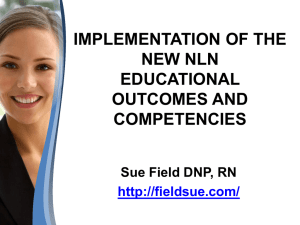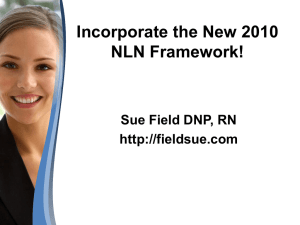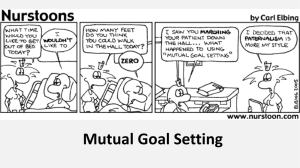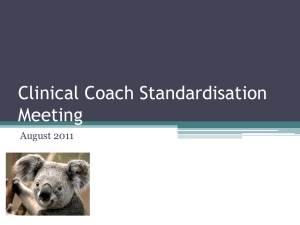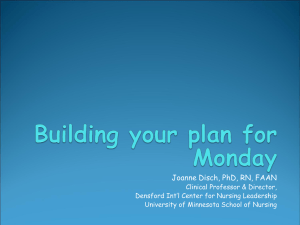Incorporating NLN Framework into your Nursing
advertisement
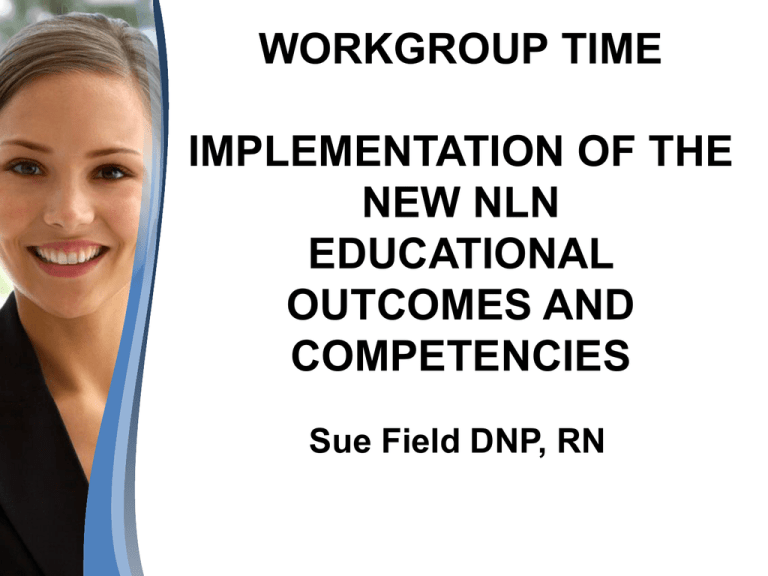
WORKGROUP TIME IMPLEMENTATION OF THE NEW NLN EDUCATIONAL OUTCOMES AND COMPETENCIES Sue Field DNP, RN NLN Framework Program Learner Outcomes NLN Learner Outcomes 1. 2. 3. 4. Human Flourishing Nursing Judgment Professional Identify Spirit of Inquiry QSEN Learner Outcomes 1. 2. 3. 4. Patient Centered Care Safety Informatics Teamwork and Collaboration 5. Evidence Based Practice 6. Quality Improvement Human Flourishing NLN Broad Learner Outcome • All Nursing Graduates independent of educational level should be prepared to promote and enhance human flourishing for patients, families, communities and themselves. Human Flourishing ADN Competency • NLN Competency for Human Flourishing • The graduate of an AD Nursing Program advocates for patients and families in ways that promote their self-determination, integrity, and ongoing growth as human beings. – QSEN Patient Centered Care Competency – The graduate recognizes the patient or designee as the source of control and full partner in providing compassionate and coordinated care based on respect for patient's preferences, values, and needs. Nursing Judgment NLN Broad Learner Outcome • All Nursing Graduates independent of educational level should be prepared to show sound Nursing Judgment. Nursing Judgment ADN Competency • NLN Competency for Nursing Judgment – The graduate will make judgments in practice, substantiated with evidence, that integrate nursing science in the provision of safe, quality care and that promote the health of patients within a family and community context. – QSEN Competency: Safety • Minimize risk of harm to patients and providers through both system effectiveness and individual performance. – QSEN Competency: Informatics • Use information and technology to communicate, manage knowledge, mitigate error, and support decision making. Professional Identify NLN Broad Learner Outcome • All Nursing Graduates independent of educational level should be prepared to continually develop their professional identity. Professional Identity ADN Competency • NLN Professional Identity Competency • Implement one's role as a nurse in ways that reflect integrity, responsibility, ethical practices, and an evolving identity as a nurse committed to evidence-based practice, caring, advocacy, and safe, quality care for diverse patients within a family and community context – QSEN Competency: Teamwork and Collaboration – The student will function effectively within nursing and inter-professional teams, fostering open communication, mutual respect, and shared decision-making to achieve quality patient care. Spirit of Inquiry NLN Broad Learner Outcome • All Nursing Graduates must approach all issues and problems in a spirit of inquiry as they move into the world of nursing practice and beyond. Spirit of Inquiry ADN Competency • NLN Spirit of Inquiry Competency – Graduate will examine the evidence that underlies clinical nursing practice to challenge the status quo, question underlying assumptions, and offer new insights to improve the quality of care for patients, families, and communities. • QSEN Competency Quality Improvement Student will use data to monitor the outcomes of care processes and use improvement methods to design and test changes to continuously improve the quality and safety of health care systems. • QSEN Competency: Evidence Based Research Student will integrate best current evidence with clinical expertise and patient/family preferences and values for delivery of optimal health care. Workgroup Time: 10 minutes Comparison of NLN/QSEN Program Learner Outcomes Pages 2 and 3 of the Workbook Section Reflections… Texting Course Outcomes • Course Outcomes – Determine the Program Learner Outcomes that the Course Outcomes are fulfilling • Determine the Learning Activities to Measure the Course Outcome – Determine the Means of Measuring the Activity See Orange Templates on the Table Person Course Outcomes Remember Your Number! 1&2 NURS 111 Introduction to Health Concepts 3&4 NUR 112: Health-Illness Concepts 5&6 NUR 113: Family Health Concepts 7&8 NUR 114: Holistic Health Concepts 9 & 10 NUR 211: Health Care Concepts 11 & 12 NUR 212: Health System Concepts 13 & 14 NUR 213: Complex Health Concepts Directions...10 minutes • Fill in the Blank spaces The NLN and/or QSEN Competencies Example: Outcome 1. Correlate the interrelationships of complex pathophysiology, and the clinical course of individuals. NLN: Nursing Judgment 1. Inputs = The Core Values • NLN Core Values: Caring, Diversity, Integrity and Excellence • NLN Framework Committee Added: Ethics, Patient Centeredness, and Holism NLN Core Value: Caring • Definition of Caring: • “Promoting health, healing and hope in response to the human condition” – “Concern and consideration for the whole person, commitment to common good, and our outreach to those who are vulnerable”. – “Act in the best interest of all stakeholders” • (NLN, 2007) NLN Core Value: Diversity • Definition of Diversity: • “Recognizing differences among “person, ideas, values, and ethnicities – Affirming the uniqueness of each – Embraces acceptance and respect – Also encompasses institutional and system wide behavior patterns” • (NLN, 2007) NLN Core Value: Excellence • Definition of Excellence: • A culture of excellence – reflects a commitment to continuous growth, improvement, and understanding. – It is a culture where transformation is embraced, and the status quo and mediocrity are not tolerated” • (NLN, 2007) NLN Core Value: Integrity • Definition of Integrity: – “respecting the dignity and or moral wholeness of every person without conditions or limitations”. – Organizational principles of • Open communication • Ethical decision making and • Humility – Are encouraged, expected, and demonstrated consistently – (NLN, 2007) NLN Core Value: Ethics • Definition of Ethics: • “reflective consideration of personal, societal, and professional values, principles, and codes that shape nursing practice…” • (NLN, 2010) NLN Core Value: Holism • Definition of Holism: • “Culture of human caring – unique and complex attributes, values, and behaviors, – individual’s environment, social norms, cultural values, physical characteristics, experiences, religious beliefs, and practices, – and moral and ethical – wellness-illness continuum”. • (NLN, 2010) NLN Core Value Patient Centeredness • Definition of Patient Centeredness • “Incorporates and reflects on the uniqueness of an individual patients – background, – personal preferences, – culture, value, – traditions and family…” • (Crownenwett et al., 2007) 1. Inputs = The Core Values • Present in your Philosophy Statement Flow through your Curriculum (Course Outcomes) To your Program Learner Outcomes Core Values Template Work-time: 5 minutes Philosophy Statement Template Course Outcomes Program Learner Outcomes Page 6 Even numbers table work on the Course Outcomes Odd numbers work on the Program Learner Outcomes 2. Throughputs = Integrating Concepts • 6 Integrating Concepts 1. Context and Environment 2. Knowledge and Science 3. Personal/Professional Development 4. Quality and Safety 5. Relationship Centered Care 6. Teamwork Apprenticeships QSEN NLN Knowledge Skills Attitudes Knowledge Practice Know How Ethical Comportment Cronenwett et al., 2007 Benner et al., 2009 Integrating Concepts Template Example Work Time • Example… Pages 6,7,8 • Round Robin at your table Each pair of faculty (2 people) that worked on course outcomes together from pages 4 to 24 will work together. Those who worked on NURS 112 and 113 will work together (4 people) . Round Robin will progress every 2 to 3 minutes… Program Learner Outcomes • “From Curricular Threads/Competencies • To Integration of the 3 Apprenticeships required for Professional Education” • “More powerful to use” • “Overarching curricular and pedagogical structure”. • From Benner, Tanner, & Chelsea. (2009) Expertise in Nursing Practice (p. 391). Program Learner Outcomes • Identifies where the student has learned the “knowledge” “practice know how” “ethical comportment” Program Learner Outcome Template Using the Round Robin Approach Identify where the Course Outcomes fit for the Program Learner Outcomes listed Program Learner Template Portfolio’s NLNAC Students Faculty What happens in clinical stays in clinical Linda Caputi, 2011 Clinical Portfolio Started with Clinical Portfolios • Listed Program Learner Outcomes • Then the Course Outcomes • Then the Learning Activities • Then the Measurement of the Activities Template • Clinical Portfolio Template Templates • Clinical I Portfolio: Part I • Clinical II Portfolio: Part II • Program Portfolio: Part III • Part I, II, and III – Combined provide proof of our student’s achievement of the Program Learner Outcomes. One Last Item • Leveling… – First semester • Knowledge and Practice Know How – 2nd semester • Practice Know How and Ethical Comportment Questions?


